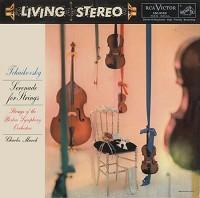Zing Went The String of the BSO
In describing the art of writing a serenade and Tchaikovsky’s relationship to it, annotator Fred Grunfeld wrote back in 1958 that the composer “prefer(ed) a well-filled concert hall to a single lady on a balcony.” No kidding!
Back then people thought Liberace was straight, so the line, intended or not, probably sailed over most “Living Stereo” LP buyers’s heads. Not so today of course, and not that this has anything to do with the quality of the composition, the performance, the recording or this reissue.
It would seem that a musical romantic like Tchaikovsky would be ideally suited to writing a piece of music dedicated to romance, especially of the longing, unrequited variety as his life apparently was mostly about that, and he scores an arrow through the heart with this lovely, tuneful piece.
Given today’s sensibilities, the lovely first movement (emotionally aimed to indicate noble, not lustful thoughts) sounds more like the intentionally humorous, ponderous anthem Elmer Bernstein wrote for “Animal House’s” Faber College than an introduction to a lady in a balcony or a romantic come-on of any sort.
The second movement’s lilting melody may be familiar to even those who don’t own a classical music recording as it’s found its way onto many “Classical Music’s Greatest Hits Collections” television commercials.
The all-string recording is from a very close perspective that offers exceptionally fine clarity and excellent delineation of the various sized strings, though of course, it is somewhat unnatural and not what you’d hear live in terms of perspective even from the fifth row, but I’d say the engineer and producer made the right choice for home listening pleasure.
The bigger instruments are reproduced with great warmth and authority on the right side of the stage (from the listener’s perspective) countered by the violins’ luscious silkiness on the left channel. Nicely leavening the closely miked perspective are the reverberant and sometimes problematic Symphony Hall acoustics.
The result is a silky-smooth, lush-sounding, grand-sweep of a recording. When the pizzicato (plucked) strings play counterpoint to the second movement’s melody, the close miking gives them hyper-dramatic transient weight that you won’t hear live but that works effectively in a recording played at home. That’s also true of the violas and basses, which rise up and dig down with greater weight than you’d hear live but if you wish to clearly hear the tonality and textures of the various strings in a symphony orchestra and how a skilled composer/arranger chooses to play them off one another, this recording can’t be beat.
I compared this reissue with a “red dog” (20S/19S) pressing. That the lacquer number got that high indicates just how popular this release originally was (or how many spoiled lacquers were produced before they got a good one).
Sometimes the “red dog” issue beats the original “shaded dog” issue but without one to compare I can’t say what the case is with this release. That said, the reissue mastered by Kevin Gray and Robert Pincus at AcousTech offers greater inner detail resolution at the expense of the greater lushness found on the original. It’s a worthwhile tradeoff as the original had “lush” to spare, though it could be argued it had detail to spare as well!
In any case, even when everyone’s sawing away intently, unlike some of the early Classic RCA reissues, the massed strings never sound hard, bright or edgy, though of course what you hear will be taste and system dependent.
A worthwhile record to reissue for the romantically inclined, strings attached!


